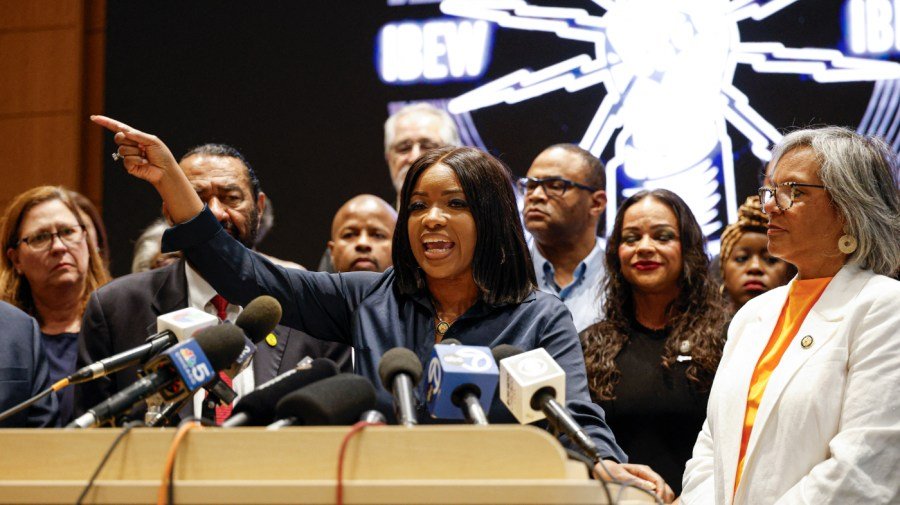
In a desperate power grab to preserve Republican control of the U.S. House in the 2026 elections, President Trump is demanding Republican elected officials in Texas and other states redraw congressional district boundaries. He aims to deprive Black and Hispanic voters — most of whom tend to support Democrats — of the ability to elect their favored candidates.
Texas Gov. Greg Abbott (R) and his fellow Republicans, who hold the majority in both houses of the state legislature, are going along with Trump’s wishes.
Abbott called a special session of the legislature to adopt a new map unveiled last Wednesday, which redraws congressional district boundaries in a way that gives Republicans an excellent chance of picking up as many as five additional U.S. House seats. This means Republicans would control of 30 of the 38 seats Texas holds.
Dozens of Democratic members of the Texas state House have left the state in a move to prevent the chamber from voting on the new congressional district boundaries that disenfranchise many Black and Hispanic Texans. The state House can only act if 100 of its 150 members are present.
Democrats hold 62 seats, and at least 51 have left the state, a spokesman said.
Abbott threatened to remove absent Democrats from office if they didn’t show up to vote on the new district map Monday afternoon, but Democrats said he had no power to oust lawmakers. Democratic House members also face $500 fines for each day they are absent from the special session.
After the absence of Democrats prevented the state House from voting on redistricting Monday, Abbott said he has “ordered the Texas Department of Public Safety to locate, arrest and return to the House chamber” any of the absent Democratic members the department can find.
Democratic lawmakers stayed away Tuesday and again prevented the House from voting on redistricting.
Four of the Democratic congressional seats Republicans see as pickup opportunities if district boundaries are changed to favor the GOP currently are or were until recently held by Black or Hispanic lawmakers. The seat once held by Democratic Rep. Sylvester Turner (D) has been vacant since he died in March.
The Constitution requires states to redraw congressional district lines every 10 years, so that all districts have roughly the same number of people, based on findings of the U.S. Census conducted once each decade. But under pressure from Trump, Texas is redistricting after only four years.
Democrats in the legislature don’t have the votes to stop this unusual move, prompting many House members to leave the state. They and others are sure to file lawsuits challenging any new district boundaries Republicans impose.
The Voting Rights Act of 1965 says no state or local government can “deny or abridge the right of any citizen of the United States to vote on account of race or color.” Among other provisions, the law bars drawing election district lines that deny minority voters an equal opportunity “to participate in the political process and to elect representatives of their choice.”
For millions of Black folks, the Voting Rights Act was our admission ticket to participate in American democracy.
My parents and many relatives in our home state of Louisiana never got to vote before the Voting Rights Act became law, because Southern states created many obstacles to Black people casting ballots as a way of keeping us politically powerless. I was a young girl in 1965, and thanks to the law I was able to vote years later when I turned 18.
Unfortunately, as we’ve seen repeatedly, Trump doesn’t let the Constitution or laws on voting rights or anything else stop him from doing what he wants.
He acts and then waits for lawsuits challenging his authority to be heard by U.S. district courts. If he loses he goes to circuit courts of appeal, and ultimately the Supreme Court, which has a 6-3 conservative majority that often favors him. This process can take many months.
The vast majority of Republicans who control the House and Senate with narrow majorities have disgracefully given up their constitutional responsibility to act as a check and balance on Trump’s efforts to do whatever he pleases. They don’t dare criticize the president, fearing he will work for their defeat in primaries.
But Democrats in Congress have no problem criticizing Trump. In a fiery statement denouncing the Republican redistricting map in his state, Rep. Marc Veasey, (D-Texas), said, “Let’s be clear — this map is racist, it’s illegal and it’s part of a long, ugly tradition of trying to keep Black and brown Texas from having a voice. What Donald Trump and Greg Abbott are doing isn’t about democracy — it’s about consolidating power.”
But because Republicans control the House with a 219 to 212 majority, with four vacancies, and they hold a 53-47 majority in the Senate, Democrats can’t stop Trump’s abuses of power.
However, if they win majority control of the House next year, they could do a great deal to block his legislative proposals and force him to make compromises, hold hearings on his actions and hold him and his appointees accountable. They could do even more if they win control of the Senate.
Trump is well aware of this, which is why he is trying to do whatever it takes to preserve the Republican majorities in the House and Senate in the 2026 elections. The party controlling the White House usually loses congressional seats in the midterms, giving Democrats an excellent chance of taking the House and a prospect of at least narrowing the Republican majority in the Senate.
The purpose of elections, of course, is to give voters the opportunity to choose the candidates they want to run government. But Trump and his enablers want to give Republican candidates the power to choose their voters by drawing district lines.
As The Hill has reported, Republicans in other states they control — Florida, Missouri and Indiana — may join Texas in partisan redistricting in an effort to keep their House majority in next year’s elections. Ohio is certain to redistrict due to a unique state law and a long-running court case, and Republicans there may choose to go hard partisan, just as in Texas.
Democrats in control of California, New York, New Jersey, Illinois and Maryland may be forced to retaliate by carving up their congressional districts in ways that help their party preserve and pick up House seats.
It’s ironic that while Trump falsely claims his 2020 reelection defeat was the result of an election rigged by Democrats, he has become the rigger in chief on behalf of Republicans with his efforts to keep control of the House through gerrymandering — drawing up election districts, often in strange shapes, to give one party an unfair advantage in elections.
Gerrymandering gets its name from Massachusetts Gov. Elbridge Gerry, who signed a bill into law in 1812 redrawing state Senate districts to the advantage of his Democratic-Republican Party. One district was said to look like a winged salamander, leading a newspaper cartoonist to draw it with the label “Gerry-mander,” which evolved into “gerrymander” years later.
Since Trump clearly loves gerrymandering and loves putting his name on hotels, resorts, golf courses, hats, steaks and other things, perhaps it’s time to retire the name “gerrymandering” and honor our president by giving it a new name.
“Trumpmandering” seems quite appropriate for a practice that needs to end.
Donna Brazile is a political strategist, a contributor to ABC News and former chair of the Democratic National Committee. She is the author of “Hacks: Inside the Break-ins and Breakdowns That Put Donald Trump in the White House.”


